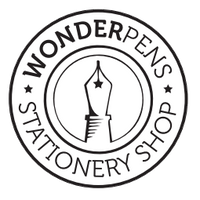I don’t know if I should call this a teal leaning blue-back or simply a dark teal with grey undertones. The colour is dark yet vivid, and is as saturated and smooth as the other Iroshizuku inks I’ve tried so far.
I liked Tsuki-Yo a lot in the shop when I tried it on a Caran d’Ache notebook laid out for clients’ use and at home on white paper; I’m not crazy about it on ivory and cream stationery—too green.
I’ve observed metallic red sheen (this is not a shimmering ink) where the ink pools in heavily saturated areas and during normal writing with my Sailor 1911L 21 kt H-B. I do like reading back pages and pages of notes with this pen and ink combination on TR 52 gsm paper, Graphilo and some Maruman; with this nib, the trade-off is the shading: there still is some, but not as much as in my Pilot Prera CM nib.
Tsuki-Yo is bluer and darker than both Ku-Jaku and Syo-Ro, but greener than Röhrer & Klingner Verdigris. It has rather long dry times on the papers I used, but dry times vary with the papers and nibs used and go from quick to long. On absorbent paper, Tsuki-Yo is very dark, uniform and uninteresting, but on less absorbent paper, its sheen makes it attractive to me.
I find that the ink used for the paper ruling has an effect on the ink, so I prefer to use paper without ruling, or at the most, with faint 5 mm dot grids.
Tsuki-Yo is readable in all nib widths, works flawlessly in my driest pen, is well-behaved and cleans fairly easily with a few extra flushes.


